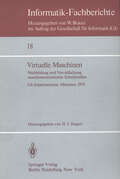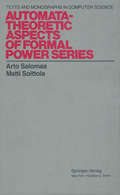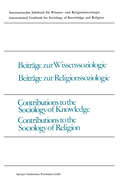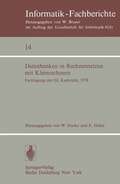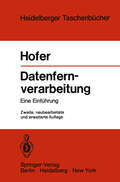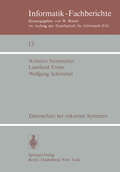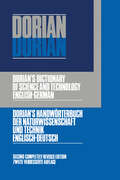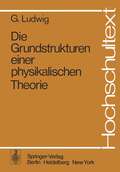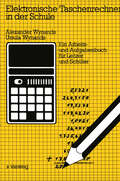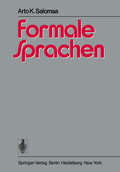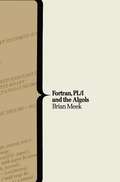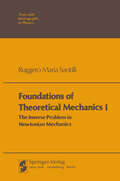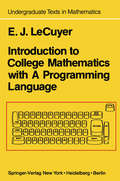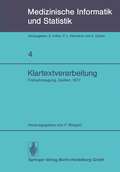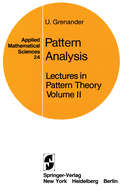- Table View
- List View
Virtuelle Maschinen: Nachbildung und Vervielfachung maschinenorientierter Schnittstellen. GI-Arbeitsseminar, München 1979 (Informatik-Fachberichte #18)
by H. J. SiegertAutomata-Theoretic Aspects of Formal Power Series (Monographs in Computer Science)
by Arto Salomaa Matti SoittolaThis book develops a theory of formal power series in noncommuting variables, the main emphasis being on results applicable to automata and formal language theory. This theory was initiated around 196O-apart from some scattered work done earlier in connection with free groups-by M. P. Schutzenberger to whom also belong some of the main results. So far there is no book in existence concerning this theory. This lack has had the unfortunate effect that formal power series have not been known and used by theoretical computer scientists to the extent they in our estimation should have been. As with most mathematical formalisms, the formalism of power series is capable of unifying and generalizing known results. However, it is also capable of establishing specific results which are difficult if not impossible to establish by other means. This is a point we hope to be able to make in this book. That formal power series constitute a powerful tool in automata and language theory depends on the fact that they in a sense lead to the arithmetization of automata and language theory. We invite the reader to prove, for instance, Theorem IV. 5. 3 or Corollaries III. 7. 8 and III. 7.- all specific results in language theory-by some other means. Although this book is mostly self-contained, the reader is assumed to have some background in algebra and analysis, as well as in automata and formal language theory.
Automated Theorem Proving: A Logical Basis (Fundamental Studies in Computer Science #1)
by D.W. LovelandAutomated Theorem Proving: A Logical Basis
Beiträge zur Wissenssoziologie, Beiträge zur Religionssoziologie / Contributions to the Sociology of Knowledge, Contributions to the Sociology of Religion (Internationales Jahrbuch für Wissens- und Religionssoziologie/International yearbook for sociology of knowledge and religion #11)
by Vojin MilićBildverarbeitung und Mustererkennung: DAGM Symposium, Oberpfaffenhofen 11.–13. Oktober 1978 (Informatik-Fachberichte #17)
by E. TriendlDie Arbeiten zu Bildverarbeitung und Mustererkennung sind ein Versuch, die Natur der Wahrnehmung zu begreifen und die menschliche Intelligenzleistung in einern schmalen Teilbereich zu unterstützen. Überdies trägt die zunehmende Verfügbarkeit von Rechenanlagen zu den weltweiten Bemühungen um Fortschritte auf diesem Gebiet bei. Neue Aspekte und Ergebnisse zeigen sich in so kurzen Abständen und in solcher Fülle, daß ein Überblick über das Gesarntgebiet der Muster erkennung in jährlicher Folge nützlich erscheint. Der vorliegende Tagungsband zeigt einen repräsentativen Querschnitt durch den Stand der Arbeiten in der Bundesrepublik im Sommer 1978. Das Symposium wird von der Deutschen Arbeitsgemeinschaft für Mustererkennung (DAGM) organisiert und von der Deutschen Forschungs und Versuchsanstalt für Luft- und Raumfahrt (DFVLR) ausgerichtet. Die DAGM ist ein Dachverband folgender wissenschaftlicher Gesellschaften: Deutsche Gesellschaft für angewandte Optik (DGaO), Deutsche Gesellschaft für Ortung und Navigation (DGON), Deutsche Gesellschaft für Medizinische Dokumentation, Information und Statistik (GMDS), Deutsche Gesellschaft für Angewandte Datenverarbeitung und Automation in der Medizin (GADAM), Gesellschaft für Informatik (GI), Nachrichtentechnische Gesellschaft (NTG). Die DAGM fördert den Erfahrungsaustausch auf dem Gesarntgebiet der Mustererkennung und ist als Nationales Komitee Mitglied der Inter national AS,sociation for Pattern Recogni ti on (IAPR). Für die Arbeit im Programm-Ausschuß möchte ich mich bedanken bei J.P. Foith, Karlsruhe; Prof. H. Niemann, Erlangen; Prof. E. Paulus, Braunschweig; Prof. G. Winkler, Karlsruhe. An der Organisation haben mitgewirkt J.P. FOith, Institut für Informa tionsverarbeitung in Technik und Biologie, Karlsruhe und H. Platzer, Lehrstuhl für Nachrichtentechnik der TU München, sowie das Institut für Nachrichtentechnik der DFVLR Oberpfaffenhofen.
Coding Theorems of Information Theory (Ergebnisse der Mathematik und ihrer Grenzgebiete. 2. Folge #31)
by J. WolfowitzThe objective of the present edition of this monograph is the same as that of earlier editions, namely, to provide readers with some mathemati cal maturity a rigorous and modern introduction to the ideas and principal theorems of probabilistic information theory. It is not necessary that readers have any prior knowledge whatever of information theory. The rapid development of the subject has had the consequence that any one book can now cover only a fraction of the literature. The latter is often written by engineers for engineers, and the mathematical reader may have some difficulty with it. The mathematician who understands the content and methods of this monograph should be able to read the literature and start on research of his own in a subject of mathematical beauty and interest. The present edition differs from the second in the following: Chapter 6 has been completely replaced by one on arbitrarily varying channels. Chapter 7 has been greatly enlarged. Chapter 8 on semi-continuous channels has been drastically shortened, and Chapter 11 on sequential decoding completely removed. The new Chapters 11-15 consist entirely of material which has been developed only in the last few years. The topics discussed are rate distortion, source coding, multiple access channels, and degraded broadcast channels. Even the specialist will find a new approach in the treatment of these subjects. Many of the proofs are new, more perspicuous, and considerably shorter than the original ones.
Datenbanken in Rechnernetzen mit Kleinrechnern: GI-Fachtagung mit Unterstützung durch das German Chapter der ACM, 11./12. April 1978, Kernforschungszentrum Karlsruhe (Informatik-Fachberichte #14)
by W. Stucky E. HollerDatenfernverarbeitung: Außenstelle — Datenfernübertragung Rechenzentrum — Betriebsabwicklung Eine Einführung (Heidelberger Taschenbücher #120)
by H. HoferDatenschutz bei riskanten Systemen: Eine Konzeption entwickelt am Beispiel eines medizinischen Informationssystems (Informatik-Fachberichte #13)
by W. Steinmüller L. Ermer W. SchimmelThe Design of Well-Structured and Correct Programs (Monographs in Computer Science)
by Suad Alagic Michael A. ArbibThe major goal of this book is to present the techniques of top-down program design and verification of program correctness hand-in-hand. It thus aims to give readers a new way of looking at algorithms and their design, synthesizing ten years of research in the process. It provides many examples of program and proof development with the aid of a formal and informal treatment of Hoare's method of invariants. Modem widely accepted control structures and data structures are explained in detail, together with their formal definitions, as a basis for their use in the design of correct algorithms. We provide and apply proof rules for a wide range of program structures, including conditionals, loops, procedures and recur sion. We analyze situations in which the restricted use of gotos can be justified, providing a new approach to proof rules for such situations. We study several important techniques of data structuring, including arrays, files, records and linked structures. The secondary goal of this book is to teach the reader how to use the programming language Pascal. This is the first text to teach Pascal pro gramming in a fashion which not only includes advanced algorithms which operate on advanced data structures, but also provides the full axiomatic definition of Pascal due to Wirth and Hoare. Our approach to the language is very different from that of a conventional programming text.
Dictionary of Science and Technology: English-German
by UNKNOWN AUTHORDorian's Dictionary of Science and Technology: English-German, Second Revised Edition focuses on the compilation of terms employed in science and technology. The book first takes a look at abduction, aberration, abhesion, abating, ablation, abscission, coupling, covering, back iron, cross-breeding, clip, cleats, channel, circuit diagram, connection, conveyors, and supercharger. The manuscript then takes a look at dabbing, dacite, dactyl, daffodil, damp, earmark, earphone, ripening, current prospecting, facilities, gaff, gablet, galaxy, gale, gait, gall, and galipot. The publication ponders on haddock, Hadley quadrant, H-bomb, habitation, habituation, hemoglobin, hailstorm, hail, halation, ichnography, iceboat, oblate, oblique, electrode structure, obesity, oatmeal, dyeing, and pachyderm. The text then explores wainscoting, waist, wale, waiver, ultrafilter, ultrahigh frequency, ulocarcinoma, elongation, vaccinal fever, vaccination, vaccine, vacancy, and vacuometer. The text is a dependable source of data for researchers interested in the terms used in science and technology.
Einführung in die Numerische Mathematik II: Unter Berücksichtigung von Vorlesungen von F.L. Bauer (Heidelberger Taschenbücher #114)
by J. Stoer R. BulirschElektronische Taschenrechner in der Schule: Ein Arbeits- und Aufgabenbuch für Lehrer und Schüler
by Alexander Wynands Ursula WynandsFoundations of Theoretical Mechanics I: The Inverse Problem in Newtonian Mechanics (Theoretical and Mathematical Physics)
by Ruggero Maria SantilliThe objective of this monograph is to present some methodological foundations of theoretical mechanics that are recommendable to graduate students prior to, or jointly with, the study of more advanced topics such as statistical mechanics, thermodynamics, and elementary particle physics. A program of this nature is inevitably centered on the methodological foundations for Newtonian systems, with particular reference to the central equations of our theories, that is, Lagrange's and Hamilton's equations. This program, realized through a study of the analytic representations in terms of Lagrange's and Hamilton's equations of generally nonconservative Newtonian systems (namely, systems with Newtonian forces not necessarily derivable from a potential function), falls within the context of the so-called Inverse Problem, and consists of three major aspects: I. The study of the necessary and sufficient conditions for the existence of a Lagrangian or Hamiltonian representation of given equations of motion with arbitrary forces; 1. The identification of the methods for the construction of a Lagrangian or Hamiltonian from the given equations of motion; and 3. The analysis of the significance of the underlying methodology for other aspects of Newtonian Mechanics, e. g. , transformation theory, symmetries, and first integrals for nonconservative Newtonian systems. This first volume is devoted to the foundations of the Inverse Problem, with particular reference to aspects I and 2.
GPSS-FORTRAN, Version II: Einführung in die Simulation diskreter Systeme mit Hilfe eines FORTRAN-Programmpaketes (Informatik-Fachberichte #6)
by B. SchmidtDer Simulation wird häufig der hohe Aufwand angelastet, der zur Erreichung von Ergebnissen erforderlich ist. Zur Zeit ist dieser Vorbehalt gerechtfertigt. Es ist jedoch zu erwarten, daB die weitere Entwicklung zu einer wesentlichen Verringerung dieses Aufwandes führen wird. Aus diesem Grunde kann man annehmen, daB die Vorteile der Simulation deutlicher in den Vordergrund treten und sich der Einsatzbereich der Simulation erweitert. Der Aufwand, der für die Simulation erforderlich ist, verteilt sich auf die folgenden drei Bereiche: * Lange Rechenzeiten * Hoher Speicherbedarf * Hohe Kosten bei der Modellerstellung Es ist bereits jetzt abzusehen, daB die Technologie in wenigen Jahren Rechenleistung und Speicherplatz zu einem Preis zur Ver fügung stellen wird, der um ein Vielfaches unter den derzeitigen Angeboten liegt. Die langen Rechenzeiten und der hohe Speicher bedarf werden daher mit Sicherheit kein Grund mehr sein, anstelle der Simulation andere Verfahren einzusetzen. Im Gegensatz hierzu ist zu erwarten, daB die Kosten, die für die Modellerstellung aufgebracht werden müssen, eher steigen.
Introduction to College Mathematics with A Programming Language (Undergraduate Texts in Mathematics)
by Edward J. LeCuyerThe topics covered in this text are those usually covered in a full year's course in finite mathematics or mathematics for liberal arts students. They correspond very closely to the topics I have taught at Western New England College to freshmen business and liberal arts students. They include set theory, logic, matrices and determinants, functions and graph ing, basic differential and integral calculus, probability and statistics, and trigonometry. Because this is an introductory text, none of these topics is dealt with in great depth. The idea is to introduce the student to some of the basic concepts in mathematics along with some of their applications. I believe that this text is self-contained and can be used successfully by any college student who has completed at least two years of high school mathematics including one year of algebra. In addition, no previous knowledge of any programming language is necessary. The distinguishing feature of this text is that the student is given the opportunity to learn the mathematical concepts via A Programming Lan guage (APL). APL was developed by Kenneth E. Iverson while he was at Harvard University and was presented in a book by Dr. Iverson entitled A i Programming Language in 1962. He invented APL for educational purpo ses. That is, APL was designed to be a consistent, unambiguous, and powerful notation for communicating mathematical ideas. In 1966, APL became available on a time-sharing system at IBM.
Klartextverarbeitung: Frühjahrstagung 1977, Fachbereich Medizinische Informatik der GMDS und Fachausschuß 14 der Gl in Gießen (Medizinische Informatik, Biometrie und Epidemiologie #4)
by F. WingertLectures in Pattern Theory: Volume 2: Pattern Analysis (Applied Mathematical Sciences #24)
by U. GrenanderMany persons have helped the author with comments and corrections, and I would like to mention D. E. McClure, I. Frolow, J. Silverstein, D. Town, and especially W. Freiberger for his helpful suggestions and encouragement. The work in Chapters 6 and 7 has been influenced and stimulated by discussions with other members of the Center for Neural Sciences, especially with L. Cooper and H. Kucera. I would like to thank F. John, J. P. LaSalle, L. Sirovich, and G. Whitham for accepting the manuscript for the series Applied Mathematical Sciences published by Springer-Verlag. This research project has been supported by the Division of Mathematical and Computer Sciences of the National Science Foundation and (the work on language abduction, pattern processors, and patterns in program behavior) by the Information Systems Program of the Office of Naval Research. I greatly appreciate the understanding and positive interest shown by John Pasta, Kent Curtiss, Bruce Barnes, Sally Sedelov vi PREFACE and Bob Agins of the Foundation, and by Marvin Denicoff of the Office of Naval Research. I am indebted to Mrs. E. Fonseca for her untiring and careful preparation of the manuscript, to Miss E. Addison for her skillful help with the many diagrams, and to S.V. Spinacci for the final typing. I gratefully acknowledge permission to reproduce figures, as mentioned in the text, from Cambridge University Press and from Hayden Book Company. Also, to Professor J. Carbury for permission to use his illustration on page 704.
